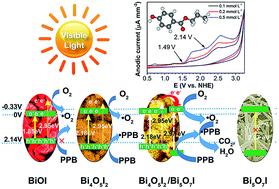Flower-like Bi4O5I2/Bi5O7I nanocomposite: facile hydrothermal synthesis and efficient photocatalytic degradation of propylparaben under visible-light irradiation†
Abstract
Nonstoichiometric bismuth oxyiodide materials have exhibited high potential for applications in visible-light photocatalytic environmental cleaning and solar energy conversion. Herein, novel Bi4O5I2/Bi5O7I nanocomposites, BiOI nanosheets, Bi4O5I2 nanoflowers, and Bi5O7I microfibers are synthesized by controlling the alkalinity of reaction solutions in a facile one-pot hydrothermal route. The as-prepared Bi4O5I2/Bi5O7I nanocomposite exhibits excellent visible-light photocatalytic performance for the degradation of propylparaben (PPB, a potential environmental contaminant structure that contains a benzene ring, hydroxyl, and carboxyl), which is approximately 32, 33, and 4 times higher than that of pure BiOI, Bi5O7I, and Bi4O5I2, respectively. The enhanced photocatalytic activity of the Bi4O5I2/Bi5O7I composite can be attributed to enhancement of charge separation by the formation of Bi4O5I2/Bi5O7I interfaces, more positive valence band edge potential at +2.18 V, good absorption from UV to visible light, three-dimensional flower-like morphology composed of number nanoflakes, and large specific surface area with mesoporous features. The band structures of Bi4O5I2 and Bi5O7I, the electrochemical oxidation behaviors of PPB, and the roles of the primary photogenerated oxidative species are analyzed, then a reasonable photocatalytic mechanism is proposed based on the experimental results. In addition, the as-synthesized Bi4O5I2/Bi5O7I heterojunction remains stable throughout photocatalytic process and can be used repeatedly, indicating its potential for practical applications.


 Please wait while we load your content...
Please wait while we load your content...